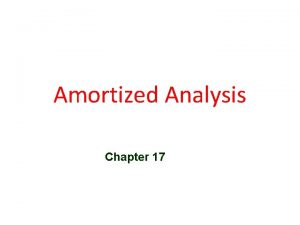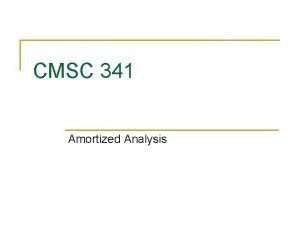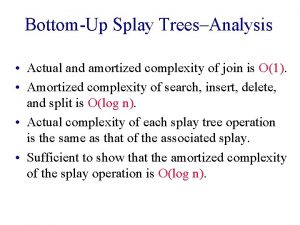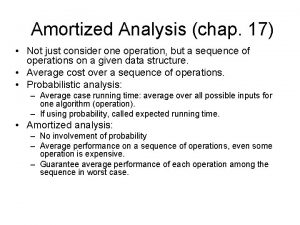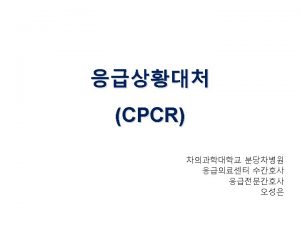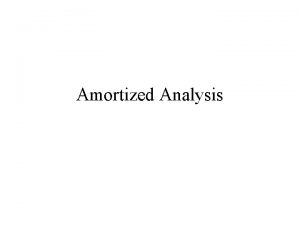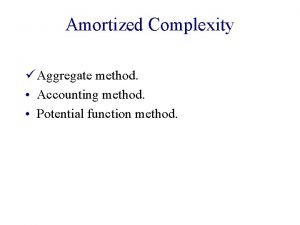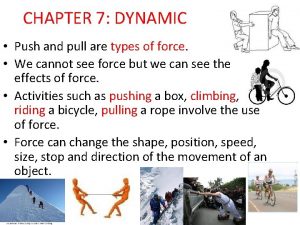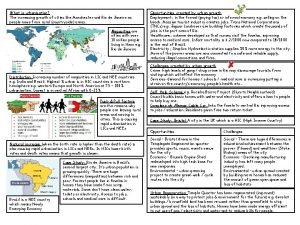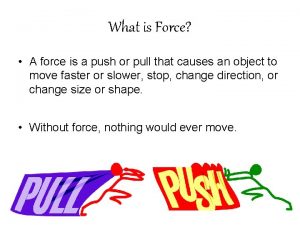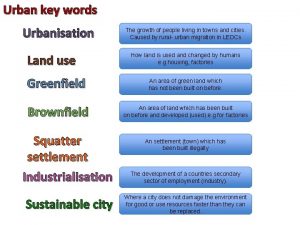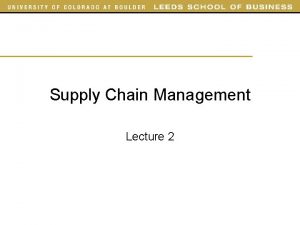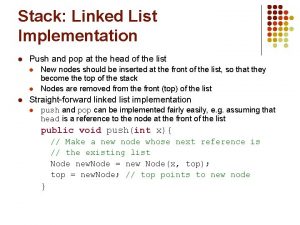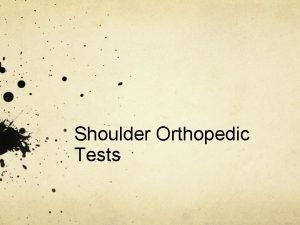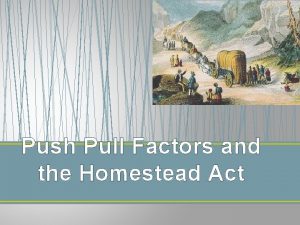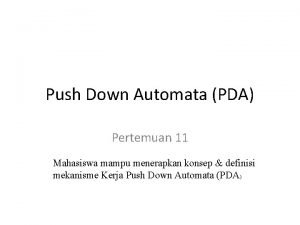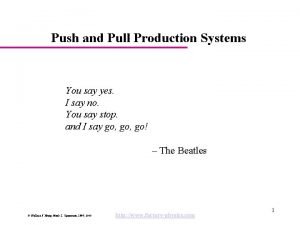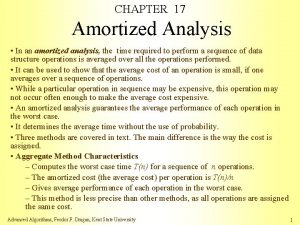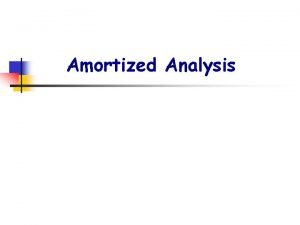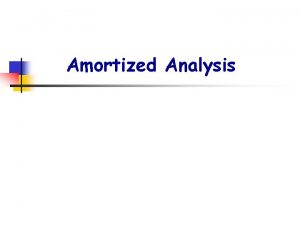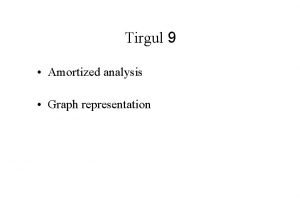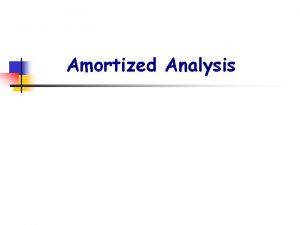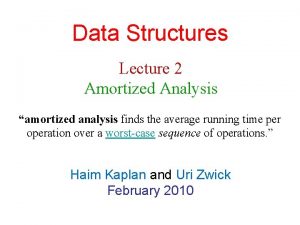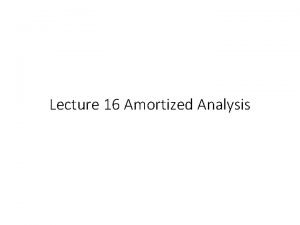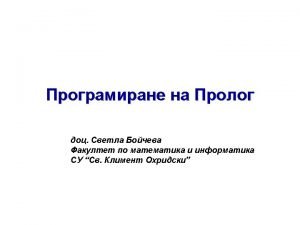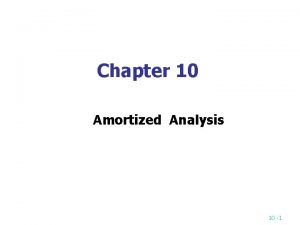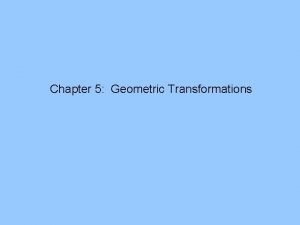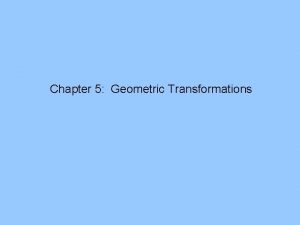Chapter 10 Amortized Analysis 1 An example push






































- Slides: 38

Chapter 10 Amortized Analysis 1

An example– push and pop A sequence of operations: OP 1, OP 2, … OPm OPi : several pops (from the stack) and one push (into the stack) ti : time spent by OPi the average time per operation: n 2

Example: a sequence of push and pop p: pop , u: push n tave = (1+1+3+1+1+1+3+2)/8 = 13/8 = 1. 625 3

Another example: a sequence of push and pop p: pop , u: push n tave = (1+2+1+1+6+1)/8 = 14/8 = 1. 75 4

Amortized time and potential function 5

Amortized analysis of the push-and-pop sequence n n Suppose that before we execute Opi , there are k elements in the stack and Opi consists of n pops and 1 push. 6

n n By observation, at most m pops and m pushes are executed in m operations. Thus, 7

Skew heaps n meld: merge + swapping Two skew heaps Step 1: Merge the right paths. 5 right heavy nodes 8

Step 2: Swap the children along the right path. No right heavy node 9

Amortized analysis of skew heaps n n meld: merge + swapping operations on a skew heap: n n find-min(h): find the min of a skew heap h. insert(x, h): insert x into a skew heap h. delete-min(h): delete the min from a skew heap h. meld(h 1, h 2): meld two skew heaps h 1 and h 2. The first three operations can be implemented by melding. 10

Potential function of skew heaps n n wt(x): # of descendants of node x, including x. heavy node x: wt(x) wt(p(x))/2, where p(x) is the parent node of x. light node : not a heavy node potential function i: # of right heavy nodes of the skew heap. 11

n Any path in an n-node tree contains at most log 2 n light nodes log 2 n # heavy=k 3 log 2 n possible heavy nodes # of nodes: n n The number of right heavy nodes attached to the left path is at most log 2 n . 12

Amortized time # light log 2 n 1 # heavy = k 1 # light log 2 n 2 # heavy = k 2 13

14

AVL-trees height balance of node v: hb(v)=height of right subtree - height of left subtree 15

n Add a new node A. Before insertion, hb(B)=hb(C)=hb(E)=0 hb(I) 0 the first nonzero from leaves. 16

Amortized analysis of AVL-trees n Consider a sequence of m insertions on an empty AVL-tree. n n T 0: an empty AVL-tree. Ti: the tree after the ith insertion. Li: the length of the critical path involved in the ith insertion. X 1: total # of balance factor changing from 0 to +1 or -1 during these m insertions (rebalancing cost) 17

Case 1 : Absorption Case 1 n The tree height is not increased, we need not rebalance it. Val(Ti)=Val(Ti-1)+(Li 1) 18

Case 2. 1 single rotation Case 2. 1 19

Case 2 : Rebalancing the tree Case 2 20

Case 2. 1 single rotation Case 2. 1 n After a right rotation on the subtree rooted at A: Val(Ti)=Val(Ti-1)+(Li-2) 21

Case 2. 2 double rotation Case 2. 2 22

Case 2. 2 double rotation Case 2. 2 n After a left rotation on the subtree rooted at B and a right rotation on the subtree rooted at A: Val(Ti)=Val(Ti-1)+(Li-2) 23

Case 3 : Height increase Case 3 n Li is the height of the root. Val(Ti)=Val(Ti-1)+Li 24

Amortized analysis of X 1 25

A self-organizing sequential search heuristics n 3 methods for enhancing the performance of sequential search 26

27

28

Analysis of the move-to-thefront heuristics § interword comparison: unsuccessful comparison § intraword comparison: successful comparison § pairwise independent property: § For any sequence S and all pairs P and Q, # of interword comparisons of P and Q is exactly # of comparisons made for the subsequence of S consisting of only P’s and Q’s. (See the example on the next page. ) 29

Pairwise independent property in move-to-the-front 30

31

§ We can consider them separately and then add them up. the total number of interword comparisons: 0+1+1+2 = 7 32

Theorem for the move-to-the- front heuristics CM(S): # of comparisons of the move-to-thefront heuristics CO(S): # of comparisons of the optimal static ordering CM (S) 2 CO(S) 33

Proof: n Inter. M(S): # of interword comparisons of the move to the front heuristics n Inter. O(S): # of interword comparisons of the optimal static ordering Let S consist of a A’s and b B’s, a b. The optimal static ordering: BA Inter. O(S) = a Inter. M(S) 2 Inter. O(S) Inter. M(S) 2 a 34

Proof (cont. ) n n n n n Consider any sequence consisting of more than two items. Because of the pairwise independent property, we have Inter. M(S) 2 Inter. O(S) Intra. M(S): # of intraword comparisons of the move-to -the-front heuristics Intra. O(S): # of intraword comparisons of the optimal static ordering Intra. M(S) = Intra. O(S) Inter. M(S) + Intra. M(S) 2 Inter. O(S) + Intra. O(S) CM(S) 2 CO(S) 35

The count heuristics has a similar result: CC(S) 2 CO(S), where CC(S) is the cost of the count heuristics n 36

The transposition heuristics n n The transposition heuristics does not possess the pairwise independent property. We can not have a similar upper bound for the cost of the transposition heuristics. 37

38
 Potential method amortized analysis examples
Potential method amortized analysis examples Amortized analysis
Amortized analysis Dynamic arrays and amortized analysis
Dynamic arrays and amortized analysis Splay tree amortized analysis
Splay tree amortized analysis Stack analysis
Stack analysis Amortized analysis
Amortized analysis Push hard push fast fully recoil
Push hard push fast fully recoil Push hard push fast fully recoil
Push hard push fast fully recoil Push hard push fast fully recoil
Push hard push fast fully recoil Push hard push fast fully recoil
Push hard push fast fully recoil Capnoea
Capnoea Mild foreign-body airway obstruction
Mild foreign-body airway obstruction Amortized complexity examples
Amortized complexity examples Amortized complexity
Amortized complexity Amortized supersampling
Amortized supersampling Potential function method
Potential function method Push and pull chapter 7
Push and pull chapter 7 Kg10m time switch
Kg10m time switch Preflow push algorithm
Preflow push algorithm Technology push vs market pull
Technology push vs market pull Push and pull factors of urbanisation
Push and pull factors of urbanisation Push and pull factors of urbanisation
Push and pull factors of urbanisation Gravity force
Gravity force Push and pull factors of urbanisation
Push and pull factors of urbanisation Curitiba sustainable city
Curitiba sustainable city Push pull in supply chain
Push pull in supply chain Senge fifth discipline summary
Senge fifth discipline summary Strategie promocji
Strategie promocji Push(stack,l)
Push(stack,l) Flussi push
Flussi push Abbott-saunders test
Abbott-saunders test Your
Your Neostick dose
Neostick dose Push dose epi
Push dose epi Push and pull scenarios
Push and pull scenarios Was the homestead act a push or pull factor
Was the homestead act a push or pull factor Makalah push down automata
Makalah push down automata Soal latihan push down automata
Soal latihan push down automata Conwip
Conwip
